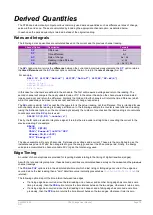
UM-0085-B09
DT80 Range User Manual
Page 60
RG
For example, if you enter
RA1+E 1V HB SATTN 4CV=4CV+1
you might expect that when the schedule was triggered (by a positive going edge on digital input 1) it would measure a
voltage (
1V
), halt schedule B (
HB
), switch on the
Attn
LED (
SATTN
) and increment a channel variable (
4CV=4CV+1
).
In fact, the
HB
and
SATTN
will execute once only, when the job is entered. The
1V
and
4CV=4CV+1
are channel
definitions, so they will execute each time schedule A is triggered.
To execute commands within a schedule, the
DO
construct can be used. This is actually a special case of the
ALARM
) – one where the condition is always true. The syntax is the same as
ALARM
except that
there is no test condition.
So if the above job was rewritten as:
RA1+E 1V DO{HB SATTN} 4CV=4CV+1
then the following actions would be performed each time schedule A is triggered:
•
Channel
1V
is measured, then channel variable
4CV
is incremented
•
The commands
HB
and
SATTN
are queued for execution. They will be actioned "as soon as possible" – once
all schedules that are currently due have completed, and any previously queued commands have been
executed.
Note:
it is not possible to interleave the execution of commands and channels within a schedule. Channels are always performed first;
commands are executed a short time later.
Commands can also be executed conditionally, using the IF construct, e.g.
RA1M IF(1CV>3.57){XB}
will test the value of 1CV once a minute. If it exceeds 3.57 then schedule B will be triggered.
For more details on
ALARM
/
IF
/
DO
syntax and usage, see
.
Time Triggers — Synchronizing to Midnight
Time triggers for report schedules function in two different ways depending on the setting of the synchronize-to-midnight
switch (
/s
or
/S
, see
).
Synchronize-To-Midnight Switch Enabled
If the synchronize-to-midnight switch is enabled (
/S
, the DT80’s default), the intervals of all schedules with time triggers
are synchronized to the previous midnight.
When a time-triggered schedule is entered, the schedules first run on the next multiple of the interval since last midnight,
and subsequently run on every multiple of the interval thereafter.
If the interval is not an even multiple of 24 hours, the DT80 inserts a short interval between the last run of the schedule
prior to midnight and the next run of the schedule at midnight.
For example, if you send the schedule
RA10H
to the DT80 at 06:00:00, it first runs at 10:00:00 (4 hours since entry, but 10 hours since midnight) and then at 20:00:00
that day; then at 00:00:00, 10:00:00 and 20:00:00 the next day; and so on.
If you enter an interval longer than 24 hours then the interval is rounded down to the nearest multiple of 24 hours. So if
the schedule
RA50H
was entered at 09:00 Monday morning then the schedule will first run at 00:00 Wednesday morning, then every 48 hours
thereafter.
Synchronize-To-Midnight Switch Disabled
If the synchronize-to-midnight switch is disabled
(/s
), the schedules run at intervals relative to the time that the
schedule is entered. For example, if the same
RA10H
schedule is sent to the DT80 at 09:30:00, it first runs at 19:30:00
that day; then at 05:30:00 and 15:30:00 on the next day; at 01:30:00 and 11:30:00 on the following day; and so on. That
is, every 10 hours of elapsed time.
Note that the base time (the time at which the specified schedule interval begins) is reset whenever:
•
the schedule rate is changed, or
•
the schedule is restarted (using the
G
command), or
•
the system time is changed (using the
D=
,
T=
or
DT
commands).
















































